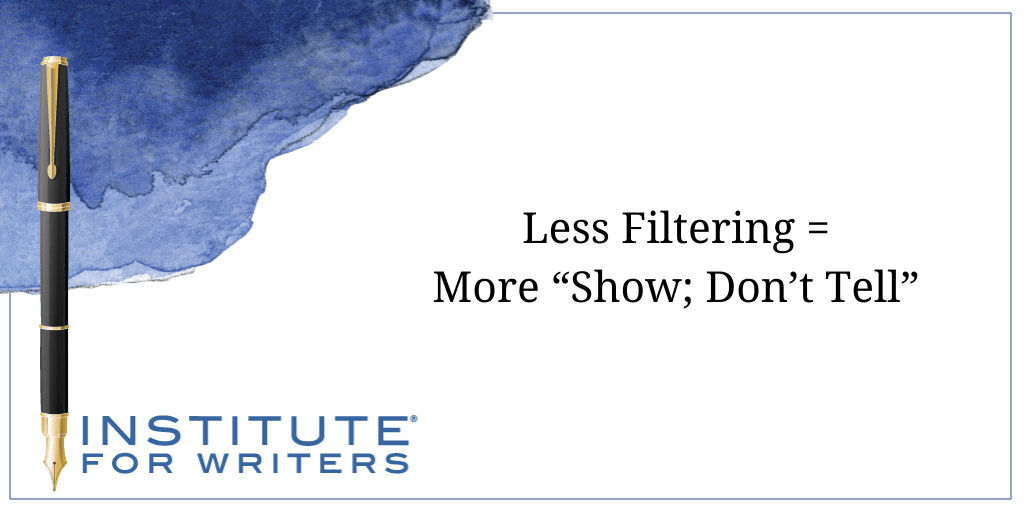
Creating Characters
Character development is an interesting part of writing but may be among the most time consuming and significant in your story.

One of our main goals in writing fiction is to reduce the distance between reader and story. We want readers to feel like they’re living the events and sharing the characters’ experiences moment-to-moment. To achieve that means “showing” rather than “telling,” and one good way to “show” is to eliminate filter words.
What are filter words? When we pour something through a physical filter, it screens the material, separating things along the way. In story scenes, filter words separate readers from the full experience by adding an extra step—one that distances readers from the action.
 Suppose, for example, your character is watching a parade. You could write: She watched the band members parade down the street. But you don’t need to say “she watched.” Since this event happened while your character was present, readers assume she watched it. Once you establish a character’s viewpoint, readers know that what they read next is coming from the character’s thoughts and perceptions. “She watched” gets in the way, focusing attention on the character’s act of perceiving the event, not the event itself.
Suppose, for example, your character is watching a parade. You could write: She watched the band members parade down the street. But you don’t need to say “she watched.” Since this event happened while your character was present, readers assume she watched it. Once you establish a character’s viewpoint, readers know that what they read next is coming from the character’s thoughts and perceptions. “She watched” gets in the way, focusing attention on the character’s act of perceiving the event, not the event itself.
Along with watched, other filter words include these words (in both present and past tense): saw, felt, thought, wondered, looked, knew, guessed, sensed, experienced, seemed, heard, smelled, noticed, decided, spotted, sighted, detected, and more. Such words can remind people they’re reading a story instead of “living” it. Using filter words also may state things that are obvious and can lead to duller writing.
Once we learn to spot filter words and phrases, we can cut them and/or replace them with writing that “shows.” As author David Madden says in Revising Fiction, “Telling is a passive experience; showing is active, immediate, involving the senses.” These revised versions of sentences with filter words use active language and sensory details to give readers a more intimate and direct experience:
Filtered: When he reached the spot where he’d parked, he could see his car was missing.
Revised: Here was the spot where he’d parked. But—where was his car? [Show his emotional response to what he saw.]
Filtered: She felt thick drops of rain pelting her bare head and neck.
Revised: Thick drops of rain pelted her bare head and neck. [Cut filter. Just show action.]
Filtered: I recognized the antique clock and knew it had been stolen from my grandmother.
Revised: Carved swans and gold Roman numerals adorned the antique rosewood clock on its oval base. Yes, that was Grandmother’s stolen clock all right. [Show specifics that caused the character to “recognize” something, and their response.]
Filtered: She wondered how she could tackle such a difficult project without help.
Revised: How could she tackle such a difficult project without help? [Phrase to show her actual “wondering” in that moment.]
Filtered: As Jeremy saw Raul standing at the foul line, he noticed that Raul looked nervous. It reminded him of the first time he had to make that shot to w
in a game.
Revised: As Raul stood at the foul line, he wiped his sweaty forehead with shaking hands and bit his lips. Jeremy’s throat tightened. I’ll never forget the first time I had to make that shot to win a game. [Show Raul’s actions directly, including signs of nervousness. Add physical sensation and internal dialogue for Jeremy.]
Filtered: I figured that with all the delays we’d never make it to the theater on time.
Revised: “Late, late, you’re always late! And now this traffic. We’ll never make it to the theater on time.” [Use dialogue to show the character’s thoughts and mood.]
Filter words do have their place. We might use them for these reasons:
To give readers needed information or better convey the meaning of the sentence. For instance, if a character was temporarily blind, it’s important to let readers know when they could see something again, say a shaft of light or the shape of a tree. Readers also might need to know what a character sees when they recall a special memory that involves the sense of sight.
 To add drama. One example: She heard the words twice, three times, but still couldn’t believe them. At times, we want to draw attention to an act that involves a filter word, such as when the character hears a noise before she discovers where it’s coming from, or when a sound comes closer and closer.
To add drama. One example: She heard the words twice, three times, but still couldn’t believe them. At times, we want to draw attention to an act that involves a filter word, such as when the character hears a noise before she discovers where it’s coming from, or when a sound comes closer and closer.
To enhance dialogue or inner dialogue.
To change the pace in a scene or reveal a shift in the mood.
To create more distance between the reader and a particular character.
Filter words tend to appear more often in stories with more narrative distance (for example, an omniscient viewpoint with multiple perspectives) than in stories with a close narrative distance using a single, consistent viewpoint.
As with other writing decisions, we can weigh the pros and cons of each approach, sentence by sentence and scene by scene. How do we want to portray our characters, and what type of experience will we give the reader?
For the most part, we’ll want to avoid filter words to let readers experience the events more directly. That means showing readers firsthand what the characters felt, decided, saw, or wondered without first telling them the character “did” those things.
Victoria Sherrow has published short stories, articles, poetry, and books for ages preschool through adult. Her books have received starred reviews and been honored by the American Library Association, Parents Choice Gold Award, National Association for the Advancement of Science, and NYPL Best Books for the Teenage, among others. An avid reader and writer since childhood, she loves helping her writing students use their unique experiences and writing styles to create stories and books.

Character development is an interesting part of writing but may be among the most time consuming and significant in your story.

Plot can be tricky, and, as a writer, you need to be aware of what makes or breaks plot. Take a look at 10 different things to avoid in your own writing.

Plot is more than just the chain of events within a story. There are so many elements to plot to consider when writing. Let’s dive into those elements.
1000 N. West Street #1200, Wilmington, DE 19801
© 2024 Direct Learning Systems, Inc. All rights reserved.
1000 N. West Street #1200, Wilmington, DE 19801
© 2025 Direct Learning Systems, Inc. All rights reserved.
1000 N. West Street #1200, Wilmington, DE 19801
©2025 Direct Learning Systems, Inc. All rights reserved. Privacy Policy.
2 Comments